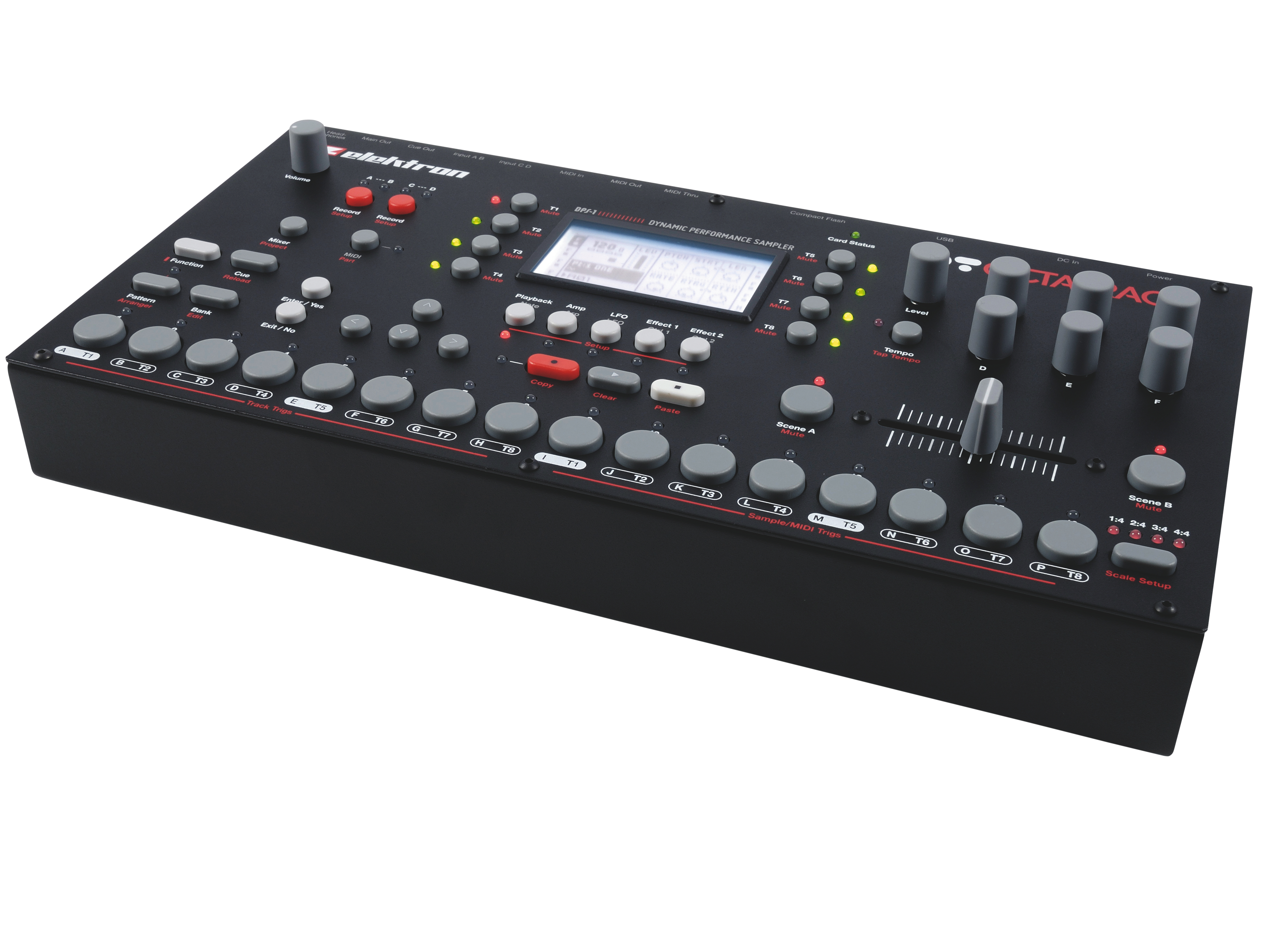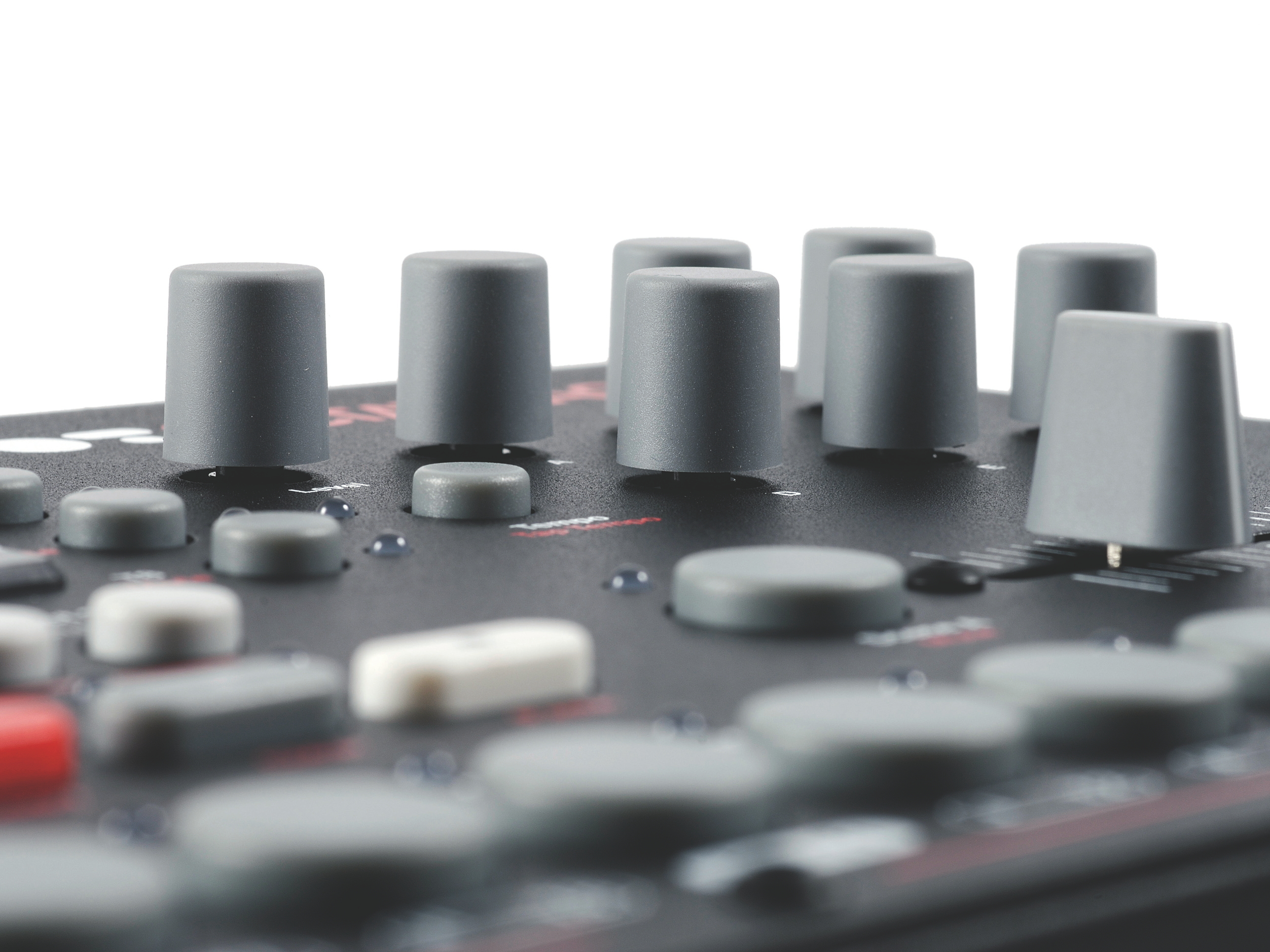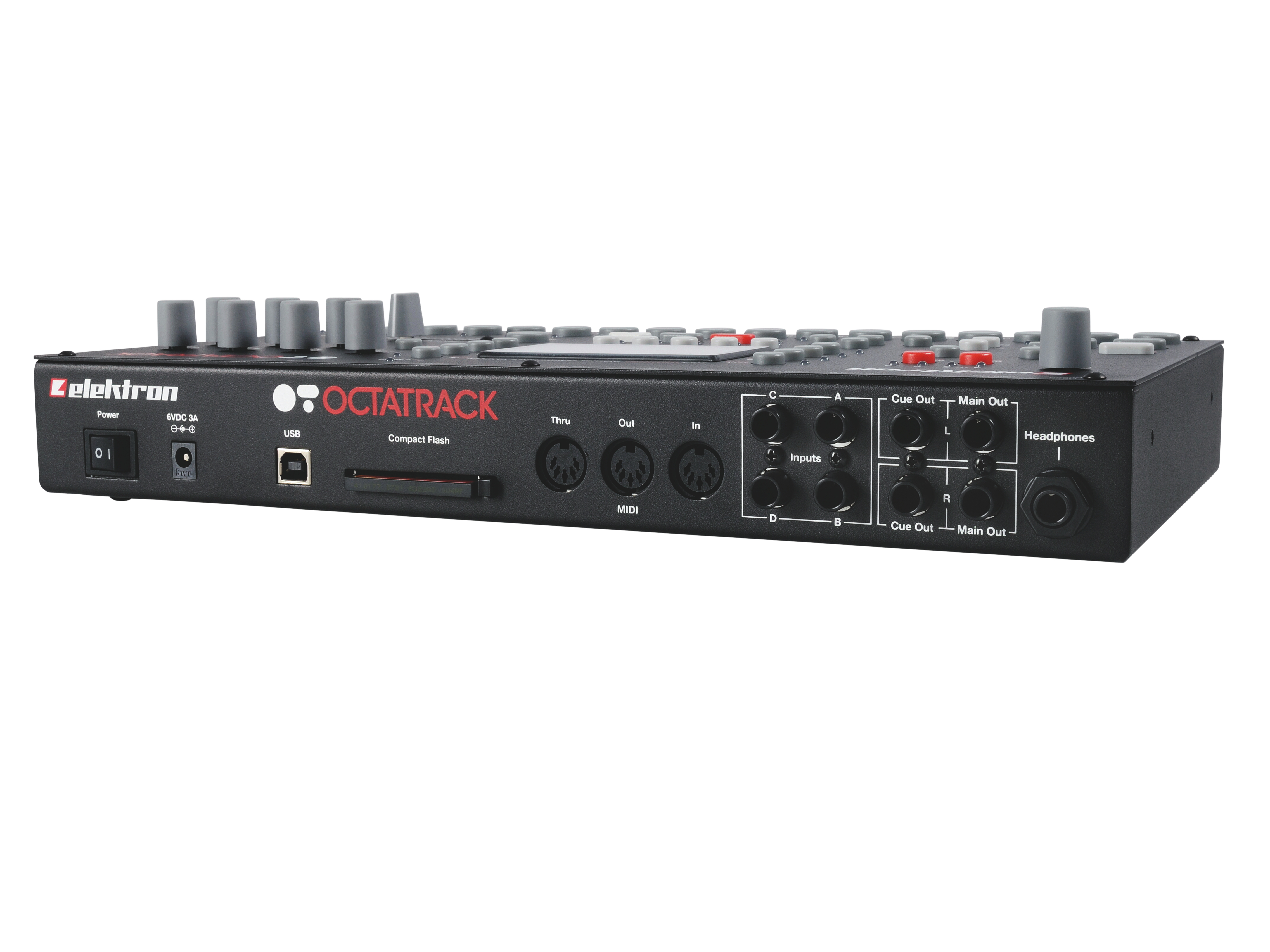MusicRadar Verdict
Elektron's reimagining results in a unique approach to sample-based composition and performance.
Pros
- +
Radically more advanced than competitors. Clean audio quality. Highly usable sample manipulation options. Outstanding build quality. Balances precision and speed.
Cons
- -
We don't agree with Elektron's claim that sampling is dying. Will take a while to get to grips with. Few outputs and expansion options. No software editor.
MusicRadar's got your back

Elektron Octatrack DPS-1

Elektron Octatrack DPS-1

Elektron Octatrack DPS-1
From the outset of this review, it's only fair to state that we fundamentally disagree with Elektron's reason for developing the Octatrack. The Swedish company - better known until now for its drum machines and synths - has declared that sampling is a dying art.
The Octatrack DPS-1, an eight-track dynamic performance sampler and sequencer, is intended to re-establish sampling as an art form.
"It'll take a while for you to uncover all its possibilities, but there's no doubt that it'll reward those with the discipline to spend time learning the intricacies of each feature."
The problem is, we're not convinced at all that sampling is dead, just that it's changed.
The reason most of us no longer use hardware samplers is that they were laborious and limited in comparison to software.
Akai's MPC workstations still have legions of fans, but the majority of us have moved to software samplers, hardware-software hybrids such as Native Instruments' Maschine or loop-based DAWs such as Ableton Live.
Even so, there's no doubt that the Octatrack takes a different approach to anything currently on the market. Perhaps the more important question isn't whether Elektron can reinvent sampling, but whether it can convince the average producer that dedicated sampling hardware is still relevant in the age of plug-ins, gigabytes of RAM and infinite track counts.
Features
The major selling point of the Octatrack is the fact that it's much more than just a sampler.
As the row of 16 buttons along the bottom of the front panel suggests, the Octatrack follows in the footsteps of the Machinedrum and Monomachine with the inclusion of a step sequencer (there are plenty more similarities, but knowledge of the other Elektron products isn't required to get to grips with the Octatrack).
What's perhaps even more important is the fact that the Octatrack's sample processing engine is radically more advanced than most hardware currently on the market. As hardware samplers were gradually usurped by their software rivals over the last decade, we came to expect a series of more advanced features.
Independent pitch and time stretching are now a mainstay of any software setup, but very few hardware units offer anything like the same level of freedom when it comes to manipulating loops and samples.
The Octatrack offers eight stereo tracks of samples plus eight tracks of MIDI step sequencing. Samples are stored on a Compact Flash card, with a maximum capacity of 64GB (the device's USB port is only used for transferring samples to the CF card from a computer). Each track is based around a 'machine' - Elektron's term for the virtual devices that generate audio or MIDI data.
For the eight sampler tracks, the main machines are Static and Flex. Static machines stream samples directly from the CF card, meaning that sample length is effectively unlimited.
Flex machines load samples into RAM for more advanced real-time manipulation, but this does mean that the total length of Flex samples is limited.
Furthermore, Thru machines allow external audio to pass through the effects, while Neighbor machines take their audio signal from the previous track, allowing longer effects chains to be created.
In use, the Octatrack's audio quality is clean, with neutral time-stretching algorithms (Normal for melodic samples and Beats for rhythmic material) and highly usable sample manipulation options.
Each track offers loop slicing, retrigger options for Beat Repeat-style effects, reverse playback and adjustable sample playback start points. Tracks can be routed through two effects (or more with the use of Neighbor machines) chosen from a range including filters, EQs, compressors and reverb.
Each machine's three LFOs and independent LFO designer (effectively a separate step sequencer for controlling parameters) allow settings to be automated in incredibly complex ways.
Overall, the options are on a par with any hardware or software sampler we've seen. The versatile options are reminiscent of Xfer's excellent Nerve drum sampling plug-in, but crucially the Octatrack's effects all work in real time without the slightest glitch.
In terms of hands-on feel, the Octatrack's build quality is outstanding. As on the other Elektron products, the rotary encoders offer dual speeds - twist to adjust a parameter normally or push and twist to adjust quickly.
Different parameters offer different levels of precision, with some requiring more encoder turns to take them from their minimum to maximum settings. As an example, adjusting the level of a track from 0 to 127 requires a turn of around 540 degrees without pushing the encoder, and just 90 degrees with it pushed. It's a perfect balance between precision and speed.
Sequencing
Let's cut to the chase: the Octatrack's step sequencer is, in a word, superb. We don't have space to talk about every detail, but suffice to say pretty much everything you'd expect from any x0x-inspired sequencer is included here, plus much more.
The lengths of each track are independently defined at anything from 1-64 steps per loop, while a separate master length can also be specified, resetting all loops after a given number of steps.
As a result, there's incredible potential to create complex polyrhythms - set up a straight kick and snare, add one or two percussion parts with different loop lengths, then sit back and let the sequencer do the hard work.
We could easily spend this entire review listing all the features of the Octatrack's comprehensive sequencer - it's an incredibly powerful setup. Micro-timing settings allow notes to be nudged backwards and forwards in 1/384th steps, while a tempo multiplier allows the track to be played back at various speeds from 1/8x to 2x the global setting.
The parameter lock feature - familiar from the Machinedrum and Monomachine - allows parameters to be set independently for each of the sample triggers (ie each active step).
In the week that we spent testing the Octatrack, we got the impression that we'd still only really scratched the surface of the sequencing options. It's a complex machine and it'll take a while for you to uncover all its possibilities, but there's no doubt that it'll reward those with the discipline to spend time learning the intricacies of each feature.
In comparison to the audio sequencing features, MIDI sequencing is relatively basic. Each MIDI machine allows only one root note per step, although tracks aren't strictly monophonic since up to four notes can be triggered simultaneously by each MIDI machine.
At this stage it would be stretching the truth to suggest that MIDI sequencing was on a par with the audio capabilities, but the Octatrack's existing features are effective and intuitive, making MIDI functionality a worthwhile addition to the bread-and-butter of sampling and sample-based sequencing.
Weaknesses
The only real weakness of the Octatrack is that it tries to do everything. That's not a problem if a piece of hardware works better than any alternative, but in certain areas it's clear that a bit more flexibility would be a benefit.
The only major limitation of the hardware itself is the absence of individual outputs: with just one pair of main stereo outputs and one pair of cue outputs, the Octatrack essentially demands that you process all your samples internally.
There's no obvious provision for any kind of expansion card, so unfortunately it seems unlikely that more outputs could be provided with an upgrade. Individual outs for each audio track would allow much more scope for external mixing and signal processing. An opportunity missed.
The biggest stumbling block for many users will lie in the fact that the Octatrack's user interface simply isn't as immediate as a software equivalent. There'll always be compromises when everything has to be displayed on a small LCD screen and controlled with just a small array of rotary encoders.
Thankfully, not too many parameters rely on the function (shift) button, and very few features require sub-menus, but we can't help but feel a software editor would make it much quicker to set up complex arrangements and sample settings.
The absence of an editor doesn't necessarily limit the potential of the Octatrack, but it makes the workflow less efficient. Working on a big screen is simply easier than squinting at a small LCD.
What's even more important is the ability to set up patches with ease, dragging and dropping samples into place and editing parameters without the need to flip from one page to another.
Programming the Octatrack involves editing up to 16 individual tracks, each of which can contain multiple scene settings. As a result, programming an entire project for a live set or studio session can take a significant amount of time.
Surely a simple software editor would speed up the workflow? Hopefully one will arrive before too long.
Elektron legacy
Elektron may believe that sampling is a dying art, but thousands of Maschine and MPC users - not to mention everyone else with a copy of Ableton Live - would surely disagree. Whether you buy into the marketing spiel or not, it's clear that the Octatrack takes a unique approach, and it's a credit to Elektron that it succeeds.
Either for studio-based production or for live performance, the Octatrack is an incredibly exciting tool. There are similarities to the Ableton workflow, but the Octatrack offers its own solution to sample-based composition, production and live performance.
Despite our concerns about the lack of individual outputs and software editing, it's an incredibly versatile product that will reward thorough exploration of its many features.
With the promise of regular updates and new features from Elektron, things can only get better. We're convinced the Octatrack will change the way a lot of people create and perform music.
Future Music is the number one magazine for today's producers. Packed with technique and technology we'll help you make great new music. All-access artist interviews, in-depth gear reviews, essential production tutorials and much more. Every marvellous monthly edition features reliable reviews of the latest and greatest hardware and software technology and techniques, unparalleled advice, in-depth interviews, sensational free samples and so much more to improve the experience and outcome of your music-making.
“Instead of labouring over a perfect recreation, we decided to make an expanded counterpart”: Chase Bliss teams up with Mike Piera for Analog Man collab based on the legendary King Of Tone
“It’s about delivering the most in-demand mods straight from the factory”: Fender hot-rods itself as the Player II Modified Series rolls out the upgrades – and it got IDLES to demo them
“For some reason, the post office shipped your guitar to Jim Root of Slipknot”: Sweetwater mailed a metal fan's Jackson guitar to a metal legend










